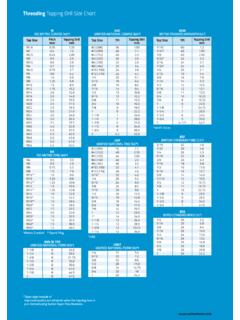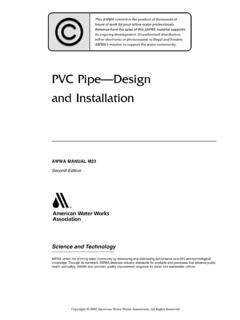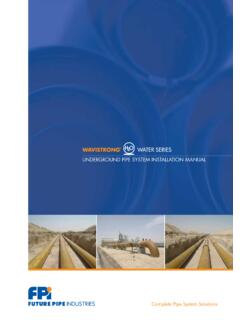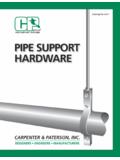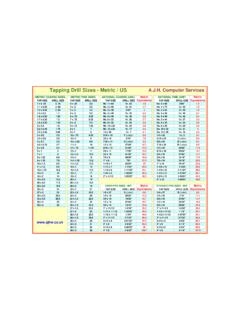Transcription of DUCTILE IRON PIPE - McWane
1 DUCTILE iron pipe The Standard for Quality andPerformanceSince its introduction into the marketplace in 1955, DUCTILE Ironpipe has been recognized as the industry standard for modernwater and wastewater systems. More than four decades of fieldexperience have proven its strength, durability, and reliability for transporting raw and potable water, sewage, slurries, andprocess s high degree of dependability is primarily due to itshigh strength, durability, and impact and corrosion and manufactured to the industry s most stringent standards, DUCTILE iron pipe resists damage during shipping andhandling, and, once installed, withstands the most demandingoperating conditions, including water hammer, frozen ground,deep trenches, areas of high water table and heavy traffic, rivercrossings, pipe on supports, rocky trenches, and areas of shifting, expansive, and unstable is simple. Unlike some pipe materials, DUCTILE Ironpipe requires no complex line-and-grade drawings or layingschedules.
2 It can be installed in a wide variety of trench and bedding conditions and can be easily cut in the field. Direct tapping , even in straight lines, doesn t affect its integrity. And,once installed, DUCTILE iron pipe is virtually maintenance pipe is manufactured in 18- or 20-foot nominal layinglengths and 3- to 64-inch diameters in a range of standard pressure classes and nominal wall thicknesses. DUCTILE iron is furnished with several different types of joints, and a wide variety of standard fittings are available without special DUCTILE iron pipe is usually furnished with cement-mortar lining, optional internal linings are also available for awide range of special DUCTILE iron s generally larger-than-nominal inside diameters,combined with its high flow coefficient, offer substantial savings on pumping and power costs over the life of the iron pipe is specified by utilities and consulting engineers for itsstrength, durability, and proven iron pipe DUCTILE iron PIPEC ontinuing the Tradition of ServiceThe strength, durability, and long service life of DUCTILE s predecessor, Gray Cast iron pipe , are widely recognized.
3 The first official record of Gray iron pipe installation was in 1455 in Siegerland, Germany. In 1664, French King Louis XIV ordered the construction of a Gray Ironpipe main extending 15 miles from a pumping station at Marly-on-Seine to Versailles to supply water to the fountains and town. This pipeserved the palace gardens for more than 330 iron pipe was introduced to the United States as early as 1817, when it was installed in the Philadelphia water system. Today,more than 611 utilities have had Gray iron distribution mains in continuous service for more than 100 years. At least 22 utilitieshave had Gray iron mains in continuous service for more than 150 years. Even Stronger and Tougher than Cast IronDuctile iron not only retains all of Gray iron s attractive qualities, such as machinability and corrosion resistance, but also providesadditional strength, toughness, and ductility. Although its chemical properties are similar to those of Gray iron , DUCTILE iron incorporatessignificant casting refinements, additional metallurgical processes, and superior quality iron also differs from Gray iron in that its graphite form is spheroidal, or nodular, instead of the flake form found in Gray change in graphite form is accomplished by adding an inoculant, usually magnesium, to molten iron of appropriate composition during to its spheroidal graphite form, DUCTILE iron has approximately twice the strength of Gray iron as determined by tensile, beam,ring bending, and bursting tests.
4 Its impact strength and elongation are many times greater than Gray iron these photomicrographs show, DUCTILE iron (above left) differs from Gray iron (above right) in thatits graphite is spheroidal, or nodular, instead of the flake form found in Gray iron . DUCTILE s greaterstrength, ductility, and toughness are due to this change in IronGray IronDUCTILE iron pipe 3 Exhibits Tremendous Tensile StrengthApipe must be able to withstand severe stresses caused externally by shifting ground and heavy loads and internally bywater pressure and water hammer. DUCTILE iron has minimum strength requirements of 60,000 psi tensile strength,42,000 psi yield strength, and 10 percent minimum Great Beam StrengthDuctile iron will bend or give considerably before it will ultimately fail. This characteristic is what makes its ductility so iron s ability to bend under load greatly increases its resistance to beam Severe Crushing LoadsExtreme traffic loads, heavy backfill, or earth movements caused by freezing, thawing, and soil swell pressuresimpose tremendous forces on buried pipes.
5 Beam tests, free bend tests, and toughest of all ring tests, whichdetermine the pipe s ability to resist concentrated loads, all demonstrate the superiority of DUCTILE iron Corrosion ResistantNumerous laboratory and field tests have proven that DUCTILE iron s corrosion resistance is equal to or greater than thatof Gray iron , which has served a number of utilities for more than 150 years with no external corrosion the majority of soils, DUCTILE iron needs no external corrosion protection. In most areas of highly corrosive soil,simple, economical polyethylene encasement has provided excellent corrosion protection for the Extremely High Impact ResistanceIn test after test, DUCTILE iron has exhibited tremendous impact resistance. DUCTILE s toughness makes it much lessvulnerable to damage from improper handling or abnormal service conditions. And it stands up under heavy trafficconditions in unstable soil environments where other materials might fail due to the stresses caused by unusual Impressive Energy SavingsDuctile s high flow coefficient (C=140) and generally larger-than-nominal inside diameters can result in increasedflow capacity, lower head loss, lower pumping costs, and significant energy savings over the life of the Virtually Maintenance FreeYears of experience in operating systems throughout the world have proven that, once installed, DUCTILE iron requireslittle, if any, maintenance over the life of the pipeline.
6 DUCTILE s longevity can be witnessed in the outstanding servicerecords of Gray iron pipe over the past 150 Tremendous Bursting StrengthDuctile s tremendous bursting strength makes it ideally suited for high-pressure applications. Six-inch Pressure Class350 DUCTILE iron , for example, has a bursting pressure exceeding 3,500 psi. DUCTILE s bursting strength also providesan additionalsafety factor against water Easy to InstallDuctile iron is easy to install in the field. A wide variety of joints and standard fittings are available for every iron can be cut and direct tapped in the field. And it requires no complex laying schedules or line-and-grade drawings.$4 DUCTILE iron pipe DUCTILE iron pipe can withstand severe crushing loads. The ring test,shown above, determines a pipe s ability to withstand load over a relatively small area, as would occur in rocky terrain where the pressure of a single rock, plus all the backfill above it, could causeweaker materials to fail.
7 A deflection gauge on the ring-crushingapparatus has been adjusted to accurately record deflection at specified load : This photograph was taken immediately after ruptureoccurred at the top of the ring. Note deflection of a full two inchesin this 8-inch DUCTILE iron of DUCTILE iron s great beam strength and durability, it is ideally suited forchallenging applications such as this pipe -on-supports iron PIPE5 The Industry s Toughest Manufacturing StandardDuctile iron pipe is a centrifugally cast product. A controlled amount of molten iron is introduced into the rotating mold, whichgenerates a centrifugal force that holds the iron in place against the mold until it solidifies. The pipe is then removed and furnace-annealed to obtain the prescribed physical following acceptance test requirements set forth by ANSI/AWWA C151 must be met before the pipe is declared readyfor shipment:1. Tensile test: Ultimate strength: 60,000 psi minimum.
8 Yield strength: 42,000 psi minimum. Elongation: 10% Impact test: 7 minimum at 70 F. 3 minimum at -40 Hydrostatic test: Every piece of DUCTILE iron pipe is subjected to a hydrostatic test of at least 500 psi before it leaves the addition to these acceptance tests, DUCTILE iron manufacturers conduct additional quality-control tests throughout the manufacturing process to ensure the highest-quality Industry s Most Comprehensive and Conservative Design StandardSince DUCTILE iron pipe s introduction in 1955, the American National Standards Institute Committee A21 (now the American WaterWorksCommittee A21) has carefully evaluated extensive data on virtually every aspect of the pipe s performance. In 1965, theCommittee s work resulted in the adoption of the American National Standard for the Thickness Design of DUCTILE iron pipe (ANSI/AWWA C150 ).This design standard is based upon the fact that DUCTILE iron pipe , when subjected to internal pressure and underground loading conditions, behaves as a flexible conduit.
9 The pipe is designed separately to withstand external loads and internal pressures. The resulting calculated thickness is greater than the thickness calculated by the appropriate equation for combining the two, andthus is more , the design procedure for DUCTILE iron pipe includes:1. Design for internal pressures (static pressure plus surge pressure allowance).2. Design for bending stress due to external loads (earth load plus truck loads).3. Select the larger resulting net wall Add an service Check Add a standard casting procedure results in the total calculated design thickness, from which theappropriate pressure class is chosen. The addition of a casting tolerance and service allowance, which is unique to DUCTILE iron pipe , therebyprovides an additional margin of safety and Design Criteria Include:1. Earth load is based upon the prism load concept, a conservative assumption forloads experienced by a flexible pipe in a Truck loads are based upon a single AASHTO H-20 truck with 16,000pounds wheel load and an impact factor of at all External load design includes calculation of both ring bending stress anddeflection.
10 Ring bending stress is limited to 48,000 psi, providing a safetyfactor of based upon minimum ultimate bending Deflection of the pipe ring is limited to a maximum of 3 percent for cement-lined pipe . Again, this limit provides a safety factor of at least againstapplicable performance limits of the lining. (Unlined pipe and pipe withflexible linings are capable of withstanding greater deflections.)5. Five trench types have been defined in the Standard (see Figure 1 on page 8) togive the designer a selection of laying conditions. This ensures a cost-effectivetrench section Internal pressure design is based upon working pressure plus a surgeallowance of 100 psi. A safety factor of is applied to this calculation.(Distribution of passivelateral soil pressures)(Distribution of passivelateral soil pressures)(Load Distribution)6 DUCTILE iron pipe In summary, ANSI/AWWA C150 design criteriainclude: ring bending stress of 48,000 psi, ring deflectionof 3 percent, AASHTO H-20 truck loading at all depthswith impact factor, prism earth load for all pipe sizes,and five types of laying conditions.
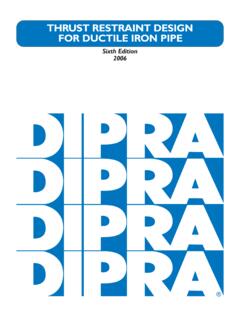
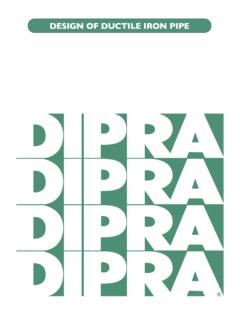

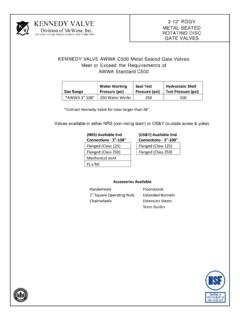
![Untitled-1 [pe.mcwane.com]](/cache/preview/0/6/a/a/7/a/e/3/thumb-06aa7ae3820fc1a116eff00b799cf8bf.jpg)
